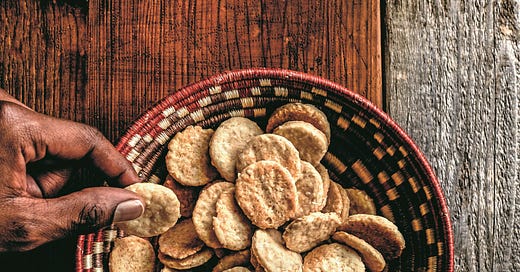Benne Wafers by Toni Tipton-Martin
Remembered in the Slave Narratives as “the grandfather of all afternoon tea refreshments,” beaten biscuits held a place of honor in black cookbooks for generations...
MAKES ABOUT 50 CRACKERS
Before the advent of baking powder and soda, beating biscuit dough with a wooden stick, hammer, or heavy rolling pin with up to one thousand whacks—a minimum of half an hour—to tenderize the dense paste was a common pathway to small, crisp “beaten biscuits.” Remembered in the Slave Narratives as “the grandfather of all afternoon tea refreshments,” beaten biscuits held a place of honor in black cookbooks for generations, presumably because white families in the Old South always considered beaten biscuits a luxury, and a hostess’s pride. The historian Arturo Schomburg’s list of party dishes included them. Street vendors in New Orleans sold them, and beaten biscuits are the very first recipe in Abby Fisher’s dignified collection from 1881, What Mrs. Fisher Knows about Old Southern Cooking.
These crackers, perfect for dips and spreads, became easier to make with the introduction of baking soda and baking powder, and took on an African character when cooks stirred in sesame seeds—called benne by African slaves—which arrived in the Sea Islands in the early eighteenth century and were cultivated in their hidden gardens for nearly a century. By the time the authors of Charleston Receipts published the recipe for the ethereal, seed-studded crackers in the mid-1950s, to which they gave the title Benne (Sesame) Seed “Cocktailers,” the New York Times assured readers that this cocktail biscuit would “revolutionize cocktail parties.”
I serve benne wafers in a sweetgrass basket I purchased from a basket weaver near Boone Hall plantation in Mt. Pleasant, South Carolina. Weaving the baskets is a craft handed down through generations of Gullah/Geechee women that enabled their African ancestors to winnow rice or carry water from a brook, stream, or well to the kitchen house. It’s my way of reconciling our artisanal past with its burdens.
Keep reading with a 7-day free trial
Subscribe to Salt + Spine to keep reading this post and get 7 days of free access to the full post archives.




